Are you draining oil prematurely or disposing an oil filter that still has life in it? If you haven’t examined drain intervals in awhile, chances are you might be throwing money away.
These days, with supply chain issues continuing to make finding parts a challenge, there’s even more of an incentive for fleets to take a closer look at preventative maintenance schedules.
In the current environment, finding a way to stretch part supplies and avoid unnecessary waste is huge. With this in mind, here are three things fleet maintenance professionals should consider doing:
#1. DOUBLE-CHECK RECOMMENDED OR EXTENDED DRAIN INTERVALS
Many OEs don’t recommend going over a certain mileage before a change is required. However, anytime a truck is brought in for maintenance, it results in repair costs and an additional expense in lost downtime for fleets.
Having a better understanding of approved extended drain intervals can help fleets save money in two ways. First, it allows you go a little longer between oil and oil filter changes, reducing your expense on additional oil and filters. Second, it allows you to coordinate other preventative maintenance requirements so that you only have to take a truck offline once, instead of multiple times.
#2. VERIFY EXTENDED DRAIN INTERVALS WITH AN OIL ANALYSIS
Changes in engine and oil technology have allowed many manufacturers to extend oil drain intervals from 30,000 miles up to 60,000, 70,000 and even 80,000 miles in some cases. But many owner/operators may be hesitant to test such limits.
A comprehensive oil analysis can help determine the ideal change interval because it takes several factors into account – operating conditions, maintenance practices and oil quality, to name a few.
#3. CONFIRM THE CORRECT FILTER IS BEING USED FOR THE APPLICATION
To protect an engine during an extended drain interval, high filter efficiency is crucial to removing contaminants that can wear down engine components. Filter capacity is also important to consider because the filter needs to be able to hold those contaminants past the service interval. Lastly, low flow restriction will help fuel economy by putting less pressure on the oil pump, while providing faster lubrication at start-up.
The components of the filter itself should be built to withstand longer change intervals as well. Silicone constructed O-rings and gaskets last longer than filters built with nitrile material, for example. To prevent the filter media from degrading and collapsing over a longer period of time, filters made with a full synthetic media and wire backing are recommended.
Luber-finer synthetic Full Flow Oil Filters cover all major engines including Cummins, Mack Volvo, Detroit Diesel, Caterpillar, PACCAR and International. To meet the need for extended drain intervals, Luber-finer offers XL (Extended Life) filters with 45% more capacity compared to standard oil filters and Time Release Technology (TRT)* filters that provide a controlled release of a highly concentrated oil additive that helps slow oil degradation and prolong oil quality over 40,000 miles.
For more information or to find an oil filter for your specific application, click here.
*TRT filters available on a limited number of SKUs














